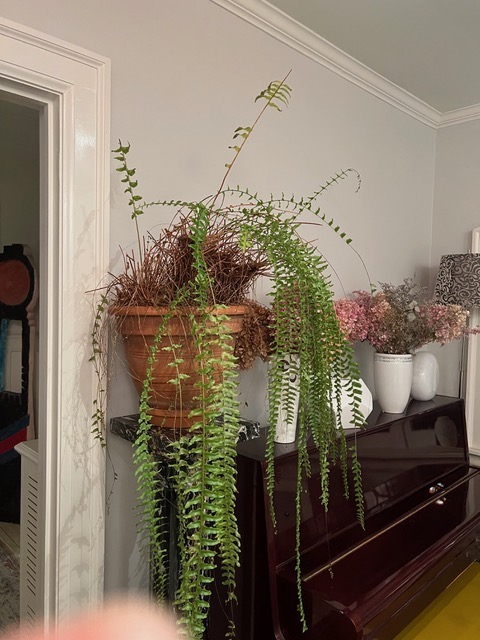
I called in last Monday to Ontario Today and spoke with Paul Zammet, in regards to reviving a 39 year old Boston Fern that I inherited from a friend.
The first picture you will see below is how we received it – which was very overgrown and filled with what we thought were dead stems, as well it was sitting in a saucer filled with water.
Then we pruned it back as seen in the second photo cutting away most of the brown stems or roots. We took your advice from our previous call and gently pulled at the top and the entire root system came out. After repotting the green leaves started to wilt more and were quite crunchy and shedding. So, I thought it was underwatered and soaked it through slowly. When doing this the water that drained out the bottom was yellow in colour and had a foul swampy smell to it. After no changes I went in for a closer examination and discovered that the roots were all brown as seen in pictures 3/4 as well as small brown and white/clear worms within the soil and on the roots. Could this be root rot and fungus gnats? I’m not ready to give up on this plant and would love your advice as to how to treat it or if you think its beautiful life has come to an end. I can send more photos
Hello – Your Boston Fern has certainly been through a lot but I wouldn’t give up just yet. So far, I understand you have pruned out most of the dead material and re-potted the fern. As no improvement has been observed, you have examined the roots more closely and found small brown/clear worms which I agree are likely fungus gnat larva. Fungus gnats are usually considered more of a nuisance but can damage roots and stunt growth when present in large numbers. Fungus gnats thrive in moist conditions and organically-rich soil so over-watering and an abundance of dead plant material has likely provided ideal conditions for the fungus gnats.
Your pruning and repotting will have removed a lot of the organic material. Now you need to get the watering under control. Wilting is not necessarily a sign that your plant needs water. It could be an indicator of root damage from the fungus gnats or other issues. Make sure the surface of the soil is completely dry before you water. Check that your plant pot is draining well and don’t let the pot sit in standing water after watering. I’m including a link below to a good article on fungus gnats and their control. Each generation takes about 17 days to develop from egg to adult. Reducing soil moisture and plant debris will make your fern a less attractive environment for future generations.
Note that as this is a US article, the insecticides noted may not be available or legal in Canada. In any case, the article indicates that insecticides are rarely warranted to control fungus gnats in the home but should you choose to use an insecticide, biological controls such as Bacillus thuringiensis subsp. israelensis (Bti) are suggested. Bti is a naturally occurring soil bacteria that is toxic to a variety of insects. It is available in Canada in various commercial products and can be used as a soil drench.
I’m including below a link to an earlier question we had on pruning Boston ferns. It has some good information on cutting back your fern to maintain both shape and good health. I’m also including a link to our Gardening Guide on growing ferns as houseplants which will provide guidance on the best light conditions, humidity and fertilizing.
Best of luck. I hope your fern pulls through.
Growing Ferns as Houseplants:A Toronto Master Gardeners Guide
Pruning a Boston Fern for the Indoor Season
17/02/23

